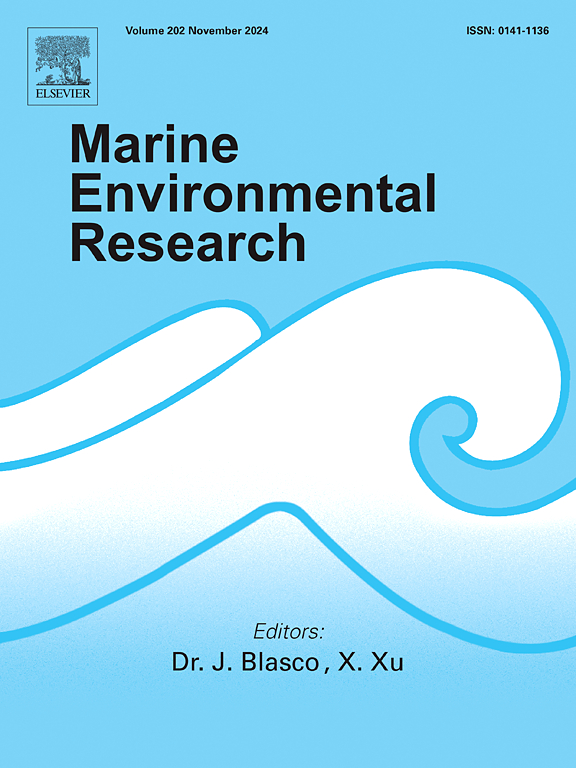早期生物膜在波罗的海传统塑料和可生物降解塑料上的定植使用中生态方法。
IF 3.2
3区 环境科学与生态学
Q2 ENVIRONMENTAL SCIENCES
引用次数: 0
摘要
生物塑料是传统塑料的有前途的替代品,但它们可能进入海洋生态系统,这凸显了更好地了解它们与微生物群落的相互作用的必要性,包括它们在塑料圈中的作用。在这里,我们使用中生态方法表征了传统塑料和生物塑料的早期生物膜形成。我们测试了一个假设,即不同的细菌群落有选择地在海洋环境中定居传统和可生物降解的塑料。具体来说,将石油基塑料聚丙烯(PP)和生物塑料聚(3-羟基丁酸酯)-羟戊酸酯(PHBv)和聚乳酸(PLA)的碎片浸泡在波罗的海mesomescs中三周。分别通过扫描电镜、荧光显微镜和16S rRNA基因元条形码分析评估生物膜定植、原核生物丰度和群落组成。随着时间的推移,传统塑料和生物塑料的生物膜发育都有所增加,光合生物在3周后出现。然而,除了聚乳酸表面外,原核生物丰度随着时间的推移而减少。在不同聚合物上形成的生物膜中,原核生物群落的组成不同。常规塑料PP上的微生物群落与对照处理下的海水相似度更高,而PLA和PHBv上的生物膜相似度更高。这些发现表明,微生物群落选择性地定植于不同类型的塑料中,生物塑料在暴露三周后支持不同和特定的细菌生物膜组合。在生物塑料中观察到的巨大多样性,特别是聚乳酸,表明在波罗的海暴露三周后,它们可能会支持更复杂和潜在活跃的塑料圈群落。本文章由计算机程序翻译,如有差异,请以英文原文为准。

Early biofilm colonization on traditional and biodegradable plastics in the Baltic Sea using a mesocosm approach
Bioplastics are promising alternatives to conventional plastics, but their potential entry into marine ecosystems highlights the need for a better understanding of their interactions with microbial communities, including their role in the plastisphere. Here, we characterized the early biofilm formation on traditional plastics and bioplastics using a mesocosm approach. We tested the hypothesis that distinct bacterial communities selectively colonize traditional and biodegradable plastics in the marine environment. Specifically, fragments of the petroleum-based plastic polypropylene (PP) and the bioplastics Poly(3-hydroxybutyrate)- hydroxyvalerate (PHBv) and polylactic acid (PLA) were submerged in Baltic Sea mesocosms for three weeks. Biofilm colonization, prokaryotic abundance, and community composition were assessed through scanning electronic microscopy analysis, epifluorescence microscopy and 16S rRNA gene metabarcoding, respectively. Biofilm development increased over time on both traditional and bioplastics, with photosynthetic organisms appearing after 3 weeks. However, prokaryotic abundance decreased over time except on PLA surfaces. Prokaryotic communities’ composition differed among biofilms formed on the different polymers. The microbial community associated with conventional plastic PP was more similar to that of the seawater in the control treatment, while biofilms on PLA and PHBv shared a higher degree of similarity with each other. These findings suggest that microbial communities selectively colonize different plastic types, with bioplastics supporting distinct and specific bacterial biofilm assemblages over three-week exposure. The great diversity observed in bioplastics, particularly PLA, suggests they may support more complex and potentially active plastisphere communities after only three weeks of exposure to the Baltic Sea.
求助全文
通过发布文献求助,成功后即可免费获取论文全文。
去求助
来源期刊

Marine environmental research
环境科学-毒理学
CiteScore
5.90
自引率
3.00%
发文量
217
审稿时长
46 days
期刊介绍:
Marine Environmental Research publishes original research papers on chemical, physical, and biological interactions in the oceans and coastal waters. The journal serves as a forum for new information on biology, chemistry, and toxicology and syntheses that advance understanding of marine environmental processes.
Submission of multidisciplinary studies is encouraged. Studies that utilize experimental approaches to clarify the roles of anthropogenic and natural causes of changes in marine ecosystems are especially welcome, as are those studies that represent new developments of a theoretical or conceptual aspect of marine science. All papers published in this journal are reviewed by qualified peers prior to acceptance and publication. Examples of topics considered to be appropriate for the journal include, but are not limited to, the following:
– The extent, persistence, and consequences of change and the recovery from such change in natural marine systems
– The biochemical, physiological, and ecological consequences of contaminants to marine organisms and ecosystems
– The biogeochemistry of naturally occurring and anthropogenic substances
– Models that describe and predict the above processes
– Monitoring studies, to the extent that their results provide new information on functional processes
– Methodological papers describing improved quantitative techniques for the marine sciences.
 求助内容:
求助内容: 应助结果提醒方式:
应助结果提醒方式:


